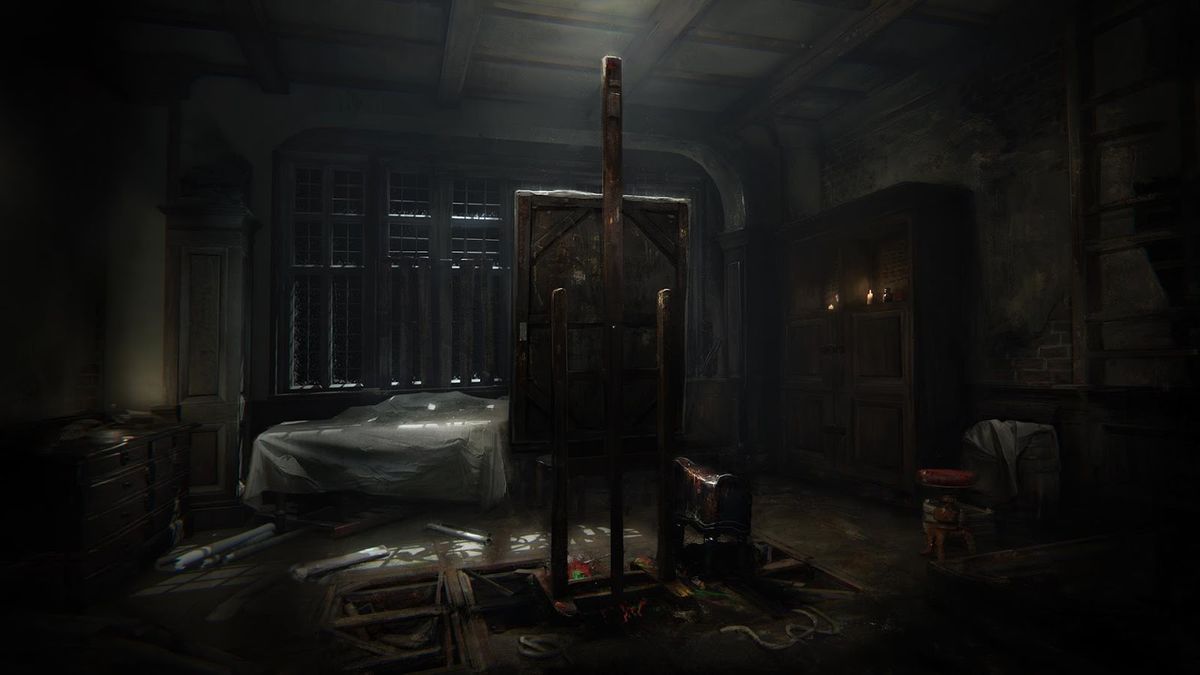Delve into the shadowy corridors of ‘Layers of Fear,’ an exploration of psychological terror and artistic madness. This article peels back the layers of the game’s narrative, mechanics, and audiovisual elements, as well as its cultural impact and connections to cinematic horror. Join us as we dissect this masterpiece of fear, examining how it captivates and terrifies players, drawing them into the depths of its twisted world.
Key Takeaways
- Layers of Fear masterfully blends psychological horror with a rich narrative, exploring the descent into madness of a tormented painter.
- The game’s use of a first-person perspective and evolving horror mechanics creates an immersive and unsettling experience.
- Sound design and music play crucial roles in amplifying the atmosphere and emotional impact of the game.
- Cinematic techniques and symbolism are woven throughout the game, paying homage to films like ‘The Mothman Prophecies’ and enriching the storytelling.
- Layers of Fear has left a lasting legacy in the horror genre, influencing future games and achieving critical acclaim for its innovative approach to fear.
Unveiling the Artistic Madness


The Tormented Painter’s Journey
In the heart of Layers of Fear, we follow the footsteps of a painter plagued by his past and ambitions. His quest to complete the Magnum Opus is not just about applying strokes to canvas; it’s a harrowing voyage through a fractured psyche. Each brushstroke reveals more than just his artistic vision—it uncovers the haunting memories and guilt that warp the very halls of the Victorian mansion he wanders.
As players, we’re not just observers but participants in the unraveling of this tragic figure. The game cleverly intertwines the painter’s backstory with gameplay, leading us down a path where the distinction between reality and illusion blurs. The mansion, a character in its own right, shifts and changes in response to our actions, reflecting the instability of the painter’s mind.
The Layers of Fear ending is a culmination of the painter’s descent into madness, as he confronts his inner demons and comes to terms with his past.
The experience is a psychological deep dive, challenging players to piece together the narrative from environmental clues and fragmented memories. The journey is as much about understanding the painter’s torment as it is about surviving the terrors that his mind conjures.
Victorian Mansion: A Labyrinth of Horror
The Victorian mansion in Layers of Fear is more than just a setting; it’s a character in its own right. The mansion’s ever-changing corridors and rooms serve as a physical manifestation of the painter’s troubled mind. As players navigate through the opulent yet decaying halls, they encounter a space that is both isolating and enveloping, reflecting the game’s themes of madness and despair.
- The mansion’s architecture, with its grand staircases and hidden rooms, creates a sense of grandeur that slowly twists into something sinister.
- Eerie paintings and cryptic messages scrawled on the walls hint at the painter’s inner demons and the tragic past that haunts him.
- The shifting layout of the mansion keeps players on edge, never knowing what horror lies around the next corner.
In this labyrinth of horror, each step forward is a step deeper into the psyche of a man consumed by his art and tormented by his past. The mansion is not just a backdrop; it’s a journey through the darkest corners of the human mind.
The Role of the Magnum Opus in the Narrative
The Magnum Opus, the elusive masterpiece sought by the tormented painter, serves as the narrative’s gravitational center. Its pursuit drives the plot forward, entangling the protagonist in a web of psychological unraveling. The game ingeniously uses the Magnum Opus as a metaphor for the character’s descent into madness, mirroring the player’s own journey through the game.
In the context of the narrative, the Magnum Opus represents more than just an artistic goal; it embodies the painter’s struggle for identity, sanity, and redemption. The layers of the painting, much like the layers of the mansion, peel back to reveal the complex history and emotions of the character.
The Magnum Opus is not merely a painting; it is the culmination of a life’s work, a symbol of the protagonist’s fractured psyche.
The game’s structure reflects the fragmented nature of the painter’s mind, with each chapter unveiling a piece of the Magnum Opus and, concurrently, a fragment of his past. The following list outlines the key elements that contribute to the Magnum Opus’s significance in the game:
- The painting’s evolving state acts as a barometer for the protagonist’s mental state.
- Each revealed layer corresponds to a pivotal moment in the painter’s life.
- The Magnum Opus is both the goal and the antagonist, a creation that haunts the painter.
- Its completion is as much about confronting personal demons as it is about artistic achievement.
The Psychology of Fear in Gaming


First-Person Perspective: Immersion into Madness
The first-person perspective in Layers of Fear is not just a camera angle; it’s a meticulously crafted conduit for psychological terror. Players become the eyes of the tormented painter, navigating through a Victorian mansion that’s as much a character as any living entity within the game. This perspective heightens the sense of immersion, making every creaking floorboard and whispered secret feel intensely personal.
- The mansion’s architecture plays tricks on your mind, with rooms and corridors that reconfigure themselves, leading to a sense of disorientation and claustrophobia.
- Visions and apparitions appear with disturbing regularity, blurring the line between reality and hallucination.
- The game’s mechanics force players to interact with the environment in ways that amplify their vulnerability, such as opening doors slowly and peering around corners.
In this realm of madness, the boundary between the game world and the player’s own psyche becomes perilously thin. The result is an experience that lingers long after the screen goes dark, a testament to the power of first-person storytelling in horror gaming.
The Evolution of Horror Mechanics
The horror genre has undergone a remarkable transformation, with mechanics that have evolved to elicit fear in increasingly sophisticated ways. Great horror movie villains with their intricate backstories have always been a staple, but the genre’s evolution has introduced a variety of sub-genres, each with its own unique approach to terror.
- Psychological horror dramas explore the depths of the human psyche, often merging the real with the surreal.
- Gothic horror brings the darkness of history to life, with settings that are as haunting as the stories they tell.
- Survival horror places characters in desperate situations, where the tension of the unknown looms large.
This diversification has not only enriched the genre but also allowed for a more nuanced exploration of fear. The future of horror, as seen through the lens of game development, promises to continue this trend, with an emphasis on psychological depth and societal reflections.
The inherent feeling of inevitability in horror creates a pervasive sense of dread. This anticipation of the inevitable is what keeps the audience on edge, even during the most mundane moments.
As we look to the future, the versatility and depth of horror mechanics are poised to captivate audiences in new and terrifying ways.
Player Agency and the Illusion of Control
In the realm of psychological horror games, player agency is often a carefully orchestrated illusion, designed to enhance the gaming experience. ‘Layers of Fear’ masterfully plays with this concept, giving players the semblance of control while subtly guiding them through a predetermined narrative path.
- The choices you make feel impactful, yet the game’s outcome remains largely unaffected.
- Exploration is encouraged, but the environment often shifts and changes, funneling players back on course.
- Puzzles provide a sense of agency, but solutions are scripted to ensure progression.
The game’s design cleverly masks the rails upon which it runs, allowing players to feel a part of the story while the game retains ultimate control over the journey.
This delicate balance between player freedom and narrative direction creates a tension that is central to the horror experience. It’s a dance between the player’s desire for autonomy and the game’s need to deliver its chilling tale.
Auditory Hauntings: The Soundtrack’s Role


Composing Terror: The Music of Layers of Fear
The soundtrack of Layers of Fear is a meticulously crafted soundscape that serves as the backbone of the game’s chilling atmosphere. Each note and chord is designed to evoke a sense of dread, playing a crucial role in immersing players in the painter’s twisted world. The music’s ability to manipulate emotions is paramount, as it guides players through the Victorian mansion’s eerie corridors.
- The main theme sets the tone for the journey, with haunting melodies that linger long after the game is turned off.
- Ambient sounds blend with the score to create a seamless audio experience, heightening the tension in each scene.
- Dynamic audio cues respond to player actions, ensuring that the fear is personalized and ever-present.
The music of Layers of Fear is not just an auditory experience; it’s a psychological tool that entwines with the gameplay to create a harrowing narrative. The composer’s understanding of horror aesthetics is evident in every track, making the soundtrack an essential element of the game’s identity.
Sound Effects: Amplifying the Atmosphere
The intricate interplay between sound effects and the visual elements of a game can transform a simple scene into a nerve-wracking experience. Sound effects are not just auditory cues; they are the unseen characters that shape the game’s atmosphere, often acting as a harbinger of the unseen horrors that lurk within the Victorian mansion.
- A sudden creak of a floorboard can send shivers down the spine.
- The echo of footsteps in an empty hall can amplify a sense of isolation.
- Whispers and groans from indistinct sources can unsettle even the most stoic players.
The right sound at the right moment can make the heart race and the palms sweat, proving that what we hear is just as important as what we see.
In ‘Layers of Fear’, the sound effects are meticulously crafted to complement the lighting and music, creating an environment that heightens anxiety and anticipation. This synergy is crucial in horror, where atmosphere is paramount. It’s all about setting the right tone, one that keeps players on the edge of their seats, eager yet apprehensive about what terror lies around the next corner.
The Emotional Impact of Audio on Player Experience
The emotional resonance of audio in gaming cannot be overstated, particularly in the realm of psychological horror. The sustained drone sounds, akin to those discussed in the context of films, trigger a visceral fear response, tapping into our primal instincts. This is not just a momentary scare; the effects can linger, altering the player’s emotional state even after the game is turned off.
- Prolonged anxiety towards in-game themes
- Heightened wariness in real-life situations
These are just a couple of the profound ways in which audio influences the player experience. A combination of sound effects and music creates an immersive atmosphere that can lead to a range of physiological responses, from an increased heart rate to sleep disturbances post-gameplay.
The power of audio in gaming extends beyond the immediate gameplay; it fosters a robust community of players who share their experiences and fears, forming bonds over shared virtual traumas.
Complex characters and narratives are amplified by the audio, making the horror feel all the more personal and immediate. As players, we confront our fears in a controlled environment, and the catharsis that comes from this can be oddly satisfying, providing an adrenaline rush without the real-world risks.
Cinematic Influences and Homages


Film Techniques in Video Game Storytelling
The art of storytelling in video games often borrows heavily from the world of cinema, and Layers of Fear is no exception. By integrating film techniques into its narrative, the game creates a deeply immersive and cinematic experience that resonates with players. For instance, the use of lighting and shadow plays a crucial role in building tension and guiding the player’s eye, much like in a suspenseful movie scene.
- The use of camera angles and framing can manipulate the player’s perception and evoke specific emotions.
- Pacing and timing of events are carefully orchestrated to maintain suspense and deliver shocks at just the right moment.
- Visual effects and transitions are employed to blur the lines between reality and hallucination, enhancing the game’s psychological horror theme.
The seamless integration of these cinematic elements not only enriches the gameplay but also pays homage to classic horror films, creating a collection of mind-bending experiences akin to watching a psychological thriller unfold.
Iconography and Symbolism: A Crossover Analysis
The intricate tapestry of iconography and symbolism in video games often mirrors the depth found in cinematic masterpieces. Layers of Fear draws on this rich tradition, embedding symbols that resonate with psychological depth and narrative complexity. For instance, the recurring motif of the Victorian mansion not only serves as a backdrop but also symbolizes the fragmented psyche of the protagonist.
In a comparative analysis, the use of symbols in both mediums can be strikingly similar. The representation of symbols in films like ‘Parasite’—ranging from the Morse code to the semi-basement—echoes in the game’s own use of cryptic messages and confined spaces to evoke a sense of entrapment and social commentary.
The symbolism in ‘Layers of Fear’ extends beyond mere aesthetic choices, becoming a vehicle for storytelling and player engagement.
The following table highlights the parallels between key symbols in ‘Layers of Fear’ and their counterparts in film:
| Symbol in Game | Film Counterpart | Perceived Meaning |
|---|---|---|
| Victorian Mansion | Gothic Architecture | Decay and Madness |
| Paintings | Film Visuals | Artistic Expression |
| Locked Doors | Barriers in Plot | Obstacles and Secrets |
By examining these parallels, players and viewers alike can gain a deeper appreciation for the narrative and emotional weight that such symbols carry.
The Mothman Prophecies: A Comparative Study
The exploration of The Mothman Prophecies in the context of Layers of Fear reveals a fascinating intersection of cinematic storytelling and video game narrative. The film’s ability to weave urban legends into a compelling narrative echoes the game’s approach to psychological horror.
The Mothman Prophecies showcases the power of urban legends and their enduring impact.
The game and the film share a common thread in their use of atmospheric tension and the unknown to drive the emotional journey of the audience. Both mediums leverage the fear of the unseen and the power of suggestion to create a haunting experience that lingers.
- The enigmatic presence of the Mothman and its philosophical quandaries about fate and premonition parallel the game’s themes of madness and reality.
- The director’s music video pedigree contributes a unique artistic vision to the film, much like the game’s meticulously crafted visual style.
- Personal trauma and the emotional heft found in the narrative resonate with players’ and viewers’ experiences, enhancing the psychological impact.
The Legacy and Impact of Layers of Fear


Cultural Resonance and Viral Moments
The cultural impact of horror dramas like Layers of Fear extends far beyond the screen, fostering robust communities and becoming cultural touchstones. Viewer engagement leads to a shared language and style, influencing not just entertainment but also fashion and language. The phenomenon is evident in how certain shows and games become part of the societal fabric, much like The Walking Dead did for zombie culture.
- Viewer engagement with horror drama often leads to robust community formation.
- Fans dissect plots, share theories, and bond over their love for the macabre.
- The sense of belonging extends well beyond the initial viewing experience.
The appeal lies in the catharsis these shows provide – allowing us to face our fears safely from our living rooms.
In terms of financial success, horror dramas can be incredibly lucrative. They often boast a loyal fan base and manage to keep production costs relatively low, resulting in significant box office numbers. The table below illustrates the average viewer numbers for premiere episodes of a popular horror series:
| Season | Average Premiere Viewers (millions) |
|---|---|
| 1 | 3.2 |
| 2 | 3.5 |
| 3 | 3.0 |
The legacy of Layers of Fear is not just in its gameplay or narrative, but in how it resonates culturally and sparks viral moments that transcend the medium.
The Game’s Reception and Critical Acclaim
Upon its release, Layers of Fear quickly cemented itself as a standout title within the psychological horror genre. The game’s innovative approach to storytelling and its immersive atmosphere were met with widespread acclaim. Critics and players alike praised the game for its ability to maintain a haunting narrative that kept them on the edge of their seats.
The game’s success is reflected in its ratings and the positive feedback from the gaming community, which highlight its impact on the genre.
While some games fade into obscurity after their initial release, Layers of Fear has enjoyed sustained popularity. This is evidenced by its continued presence in discussions about top horror games, often compared to genre-defining titles like Amnesia: The Dark Descent and What Remains of Edith Finch.
- The Hollywood Reporter lauded the game for its clever narrative twists.
- Financial success led to the development of sequels, expanding the Layers of Fear universe.
- The game’s unique blend of horror elements has influenced a number of subsequent titles in the genre.
Influence on Future Psychological Horror Games
The legacy of Layers of Fear extends beyond its immediate reception, casting long shadows over the landscape of psychological horror games. The game’s innovative approach to storytelling and atmosphere has become a benchmark for future titles in the genre. Developers now strive to emulate its success by blending deep psychological narratives with immersive gameplay experiences.
- Psychological horror games now often feature complex characters with rich backstories, much like the tormented painter of Layers of Fear.
- The use of a first-person perspective to enhance player immersion has become more prevalent.
- There is a greater emphasis on audio design to evoke emotional responses and build tension.
The influence is evident in the way new games are crafted, with a clear nod to the pioneering elements that made Layers of Fear a standout experience. The game has not only set new standards but also inspired a creative renaissance in the horror genre, encouraging developers to explore the depths of fear with greater artistic freedom and psychological insight.
Conclusion
In the end, ‘Exploring the Layers of Fear’ has taken us through a labyrinth of psychological terror and artistic madness, both in the realm of gaming and cinema. From the eerie corridors of a Victorian-era mansion in the original ‘Layers of Fear’ game to the unsettling depths of the ocean liner in its sequel, we’ve navigated the twisted minds of characters grappling with their inner demons. The parallels drawn with the haunting cinematic journey of ‘The Mothman Prophecies’ have only deepened our appreciation for the craft of horror storytelling. Whether it’s through the chilling soundtrack that underscores the tension or the rich occultist lore that invites endless decoding, these works of horror compel us to confront the primal fears that lurk within the human psyche. As we close this chapter, we leave with a heightened sense of admiration for the creators who masterfully weave these tales and a renewed eagerness to face the fears that await in the shadows of our own imaginations.
Frequently Asked Questions
What is Layers of Fear?
Layers of Fear is a first-person psychedelic horror game released in 2016, focusing on story and exploration. Players assume the role of a painter working to complete his Magnum Opus while navigating a constantly changing Victorian-era mansion filled with terrifying visions.
How does Layers of Fear 2 differ from the original game?
Layers of Fear 2, released in 2019, is a first-person psychological horror game where players control a Hollywood actor taking the lead role in a film shot aboard an ocean liner. The sequel builds on the themes of the original but with a new setting and narrative twists.
What makes Layers of Fear stand out in the horror game genre?
Layers of Fear stands out due to its heavy emphasis on atmospheric tension, psychological horror, and a deep narrative that unfolds through exploration. The game’s unique art style and first-person perspective create an immersive experience that challenges players’ courage.
What are the main themes explored in Layers of Fear?
The main themes in Layers of Fear include the psychology of fear, the descent into madness, the struggle for artistic creation, and the impact of past traumas. The game explores these themes through its narrative, gameplay mechanics, and atmospheric design.
How does the soundtrack contribute to the Layers of Fear experience?
The soundtrack in Layers of Fear plays a crucial role in building the game’s eerie atmosphere. The music and sound effects work together to amplify the sense of dread and terror, enhancing the emotional impact on the player’s experience.
Has Layers of Fear had a significant impact on the horror game industry?
Yes, Layers of Fear has had a notable impact on the horror game industry. Its success in creating a psychologically intense experience has influenced future psychological horror games, and it has garnered critical acclaim for its innovative approach to storytelling and fear-inducing gameplay.






